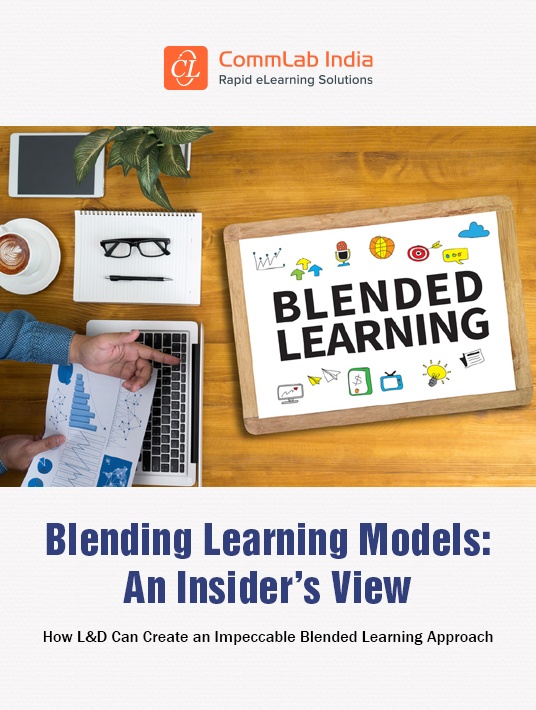What To Avoid If You Want To Get Blended Learning Right
Contrary to popular belief, blended learning involves a lot more than simply converting your existing content for online delivery or finding digital alternatives for face-to-face classroom courses. In an ideal situation, designing a blended learning strategy would start with identifying learning outcomes, defining topics, ideating assignments and activities, finding how interactions will take place, and deciding on the right digital learning technologies to achieve the desired learning objectives [1].

However, there are a lot of constraints that may get in your way of creating an effective blended learning program. So, how do you ensure an impactful blended learning approach without compromising on quality?
Read on to discover the 5 pitfalls that can hamper your attempts to create an effective blended learning strategy for workplace training.
1. Trying To Fit Existing Content Without Adapting For Blended Delivery
While it would save a lot of time to use existing content, using the same content without modifying it would only lead to ineffective training. After all, training content (PPTs, handouts, charts, and so on) used for lengthy classroom training sessions cannot be used as is in eLearning courses.
Hence, it’s essential to review the existing content—for relevance and gaps—and modify it as needed for different delivery formats, be it VILT, eLearning, or other digital learning assets [2].
However, all this might seem much easier said than done. How do you decide which content is appropriate for which delivery platform in a blend? What should the criteria be to do so? You need to consider the job task inventory to answer these questions and to design the optimum blend for maximum results.
| Insight
A job task inventory lists down tasks that an employee has to do as part of their job. The inventory categorizes tasks based on their:
|
Let’s see how these parameters affect the design of blended learning for a particular task.
If your job task inventory matrix shows that a task rates high in complexity and importance, it is better to have more Instructor-Led Training in the classroom—with the instructor available in real time—rather than online training. eLearning can be used after the initial classroom training to supplement the classroom session.
Here’s how the blend can be designed:
- ILT session with a trainer/SME for detailed information on the task and risks involved
- eLearning with demo videos to demonstrate how the task should be performed
- Simulations, assignments, social learning for practice opportunities with immediate feedback
- Coaching and job aids to improve proficiency in the task
However, if the task rates low on the parameters (not frequent, not complicated, not risky), you can offer refresher courses periodically along with performance support for reference before the learner performs the task.
2. Using Irrelevant Digital Learning Assets In A Blend
If the task is complicated and requires high precision, simply offering demo videos and infographics would not make for effective training! Such tasks would need expert guidance and hands-on experience to ensure error-free performance. This can be done through workshops or even eLearning simulations [3].
Hence, it’s always important to consider the function (the task) before choosing the form (the digital learning method) rather than going for the latest technology just because it seems "cool" or "hi-tech." To put it simply, the format of learning should depend on its intended purpose.
Let’s look at some formats based on their function or application.
| Form | Function |
| VILT (Virtual ILT) (digital alternative to ILT) | For complex, important, risky tasks that require SME/instructor’s intervention |
| Videos | To demonstrate features of a product or steps to operate a piece of equipment |
| Workshops | For real-time experience under guided supervision and instant feedback for complex tasks |
| Simulations | For hands-on practice |
| Quizzes | For pre- and post-assessments of learning as well as for reinforcement |
| Interactive infographics/PDFs | As quick reference tools |
It’s also important to consider your technological infrastructure and learner preferences before finalizing the digital method. For starters:
- Do your learners use desktops or laptops for online training?
- Do you have an LMS to administer and track learning initiatives?
- If you want to use Virtual Instructor-Led Training instead of ILT [4], would your instructor and learners be able to manage the digital shift?
- Which virtual platform will you use for VILT sessions?
- Do you have a BYOD policy or will your organization provide the mobile devices for training?
So, take your time, determine the function first, and then choose the format to achieve the desired outcome.
3. Neglecting To Orient Learners On Digital Learning Methods
If your learners have only been used to in-person classroom training and are very comfortable with it, they would not be very receptive to online training, at least at first. Venturing into anything new needs orientation, if not training. Similarly, your learners would also need an introduction to online training when they begin the blended learning journey—be it eLearning, virtual classrooms, or mobile learning.
The idea is to familiarize them with all the "how to use" aspects and allay any apprehensions in first-time digital learners. Here are some ideas on how you can make your learners comfortable with digital learning in a blended learning program.
- Offer a how-to guide (or videos) on navigating eLearning and mobile learning courses [5].
- Inform learners about what’s in it for them in the course to show the relevance of the online training in the blend. You can also inform them of the benefits of eLearning and how it’s as impactful as in-person classroom training sessions.
- Be sure to orient your learners on virtual platforms if you’re going for VILT. Here also, you can offer how-to guides on using the features of the virtual platform, host an online discussion to address any queries they might have about the virtual shift, and so on.
- Even instructors should be trained on how to make the most of the features offered by the virtual platform they will be using.
- Integrate social learning elements into your blended program to support learners in online discussion forums on the LMS or social media handles such as LinkedIn or Facebook [6].
4. Ignoring Evaluation And Tracking Of Learners’ Progress
Keeping track of learners’ progress in a blended program is crucial to assess the impact of the program, but it can be quite challenging. Both classroom and online methods of a blended delivery have to be tracked to ensure learning success. That means it is necessary to include assessments for both classroom as well as online training.
Needless to say, these assessments will not only help gauge the progress of your learners but also give them an opportunity to pinpoint their areas for improvement.
If your Learning Management System (LMS) is compliant with eLearning technology standards such as SCORM 2004 and xAPI, you can even track offline learning activities, for instance, courses downloaded and accessed offline on mobile devices.
Here are some tips to ensure effective assessments:
- Include formative (after every learning point) and summative assessments (at the end of a course). You can even conduct the assessments of all ILT sessions online. This allows you to effectively manage and track learners’ progress.
- Ask learners to summarize their learning in a self-learning activity (e.g., refection activity). Include a summary at the end of each module for a quick recap.
- Include group-based activities to make assessments fun. You can use breakout rooms (in virtual training platforms), the LMS, and social media sites to host discussions, gamified tasks such as formulating action plans and strategies (where learners use their acquired knowledge), and so on.
Ascertain that all learning requirements have been met by tracking and monitoring the results of the assessment. To ensure that training expectations are met, it is a good idea for instructors or online administrators to interact with learners occasionally.
5. Skipping Post-Training Support
To ensure sticky learning that translates into effective performance on the job, it is important to offer post-training reference resources, refresher courses (spaced over time), and performance support (at the moment of need). All in all, skipping post-training support can prove costly in terms of failing to achieve the desired results.
Microlearning is probably the best solution for effective post-training support. You can leverage various microlearning assets such as videos, blogs, infographics, game-based nuggets, audio podcasts, and so on. You can even record virtual training sessions and configure them down into microlearning modules—dealing with one learning objective each—as post-training references.
Example
Here are different microlearning assets that can be offered as performance support for product sales training.
- Flashcards for an overview of product features
- Infographics for dos and don’ts
- How-to videos on the FAQs of product troubleshooting
- Scenario-based nuggets to help learners make the right decisions
To put it simply, microlearning can be your one-stop solution for impactful post-training support in a blended learning program, without taking too much effort and time.
Wrapping It Up!
While blended learning is one of the trending methods to deliver learning, it is important to get it right. As with any other new initiative, it is a good idea to do some ground research before you go for it. When you begin your journey of designing blended learning, keep in mind these pitfalls and you will not go wrong!
Download the eBook An Insider's View On Blending Learning Models: How L&D Can Create An Impeccable Blended Learning Approach and find out how blended learning enhances training, the best blended models, tips for successful implementation, and more. Also, get to join the webinar on blended learning to discover new solutions to old problems.
References:
[1] 5 Tips to Set Flawless Learning Objectives for eLearning Courses
[2] 5 Exciting Digital Learning Formats to Deliver Organizational Knowledge
[3] Making E-learning More Engaging with Software Simulations
[4] A Tried & Tested Recipe for Successful Virtual Instructor-led Training
[5] 5 Ideas to Build an Engaging Mobile Learning Experience
[6] How to Incorporate Social Learning in eLearning?








